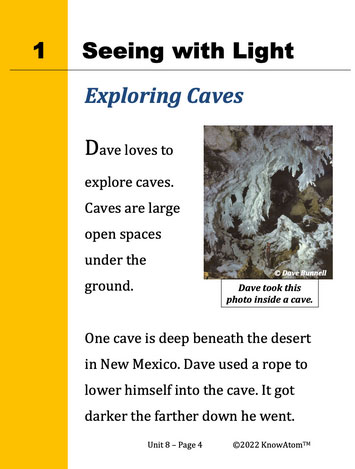In this lesson, students carry out two investigations to observe how materials with different properties interact with light in various ways.
In this unit, students explore the science phenomena of light and the relationship between sight and light. In this lesson, students carry out an investigation to observe how materials with different properties interact with light in various ways. They analyze how much light passes through different materials, and then investigate how the path of a flashlight’s beam of light changes when it comes into contact with a mirror. This page showcases each component of this lesson.
The science background provides teachers with more complex information about the phenomena students study in this unit, in this case, materials and light.
Whether a material is opaque, transparent, or translucent depends on its properties, which in turn depends on its atomic structure. Most objects reflect light off of their surface and into our eyes. To reflect means to bounce off of. This is how we see. Sight is a sense that uses the eyes to take in light information about an object’s position, shape, and color.
Without light reflecting off of different objects and into our eyes, we cannot see. This is why cave explorers such as Dave Bunnell bring their own light, including headlamps and flashlights, as they descend deep underground. If these explorers were to turn off their light sources, they would be completely in the dark and therefore unable to see anything around them.
The eye, which is the part of the body used for sight, turns the light that has reflected off of different objects into images that allow us to pinpoint objects in space and to identify their colors and shapes. The difference between materials that are transparent, translucent, or opaque has to do with how light reflects off of a surface and into the eyes.
In this lesson, students carry out two investigations to observe how materials with different properties interact with light in various ways.

Prepared hands-on materials, full year grade-specific curriculum, and personalized live professional development designed to support mastery of current state science standards.
Opaque: a material that blocks all light
Reflect: to bounce off of
Sight: the sense that uses the eyes to take in light information about an object’s position, shape, and color
Rransparent: a material that light passes through completely
Rranslucent: a material that some, but not all, light passes through
A Reflective Salt Flat
Luca Galuzzi travels the world. He takes pictures of what he sees. On one trip, he stood on top of a giant salt flat. This is a wide-open area covered with salt. When water covers it, this area becomes the world’s largest natural mirror.
Objects Reflect Light
The sky appears to be on the ground. This is because of how the water in the salt flat reflects light. To reflect means to bounce off of. All objects reflect some light. This is how we see them. Light reflects off of the object and into our eyes.
Some objects reflect more light than other objects. Shiny, smooth objects reflect more light than dull or rough objects. Light-colored objects also reflect more light than dark-colored objects.
Some objects reflect light in a way that lets you see images on their surface. This is what happens with mirrors. When you look in a mirror, your image reflects back. It is also what happens with the water in the salt flat.



This lesson has two investigations. In the first investigation, students plan and carry out an investigation to help them answer the focus question: “Does light pass through all materials the same way?” In the second investigation, students explore the focus question: “How do mirrors change the light beam from a flashlight?” Students work collaboratively as a class to develop a procedure that uses the available materials to test their prediction about the answer to the question. Then, students investigate how a flashlight’s beam of light changes when it comes into contact with a mirror.
KnowAtom incorporates formative and summative assessments designed to make students thinking visible for deeper student-centered learning.

Standards citation: NGSS Lead States. 2013. Next Generation Science Standards: For States, By States. Washington, DC: The National Academies Press. Neither WestEd nor the lead states and partners that developed the Next Generation Science Standards were involved in the production of this product, and do not endorse it.
